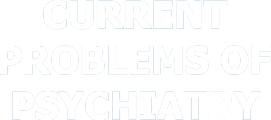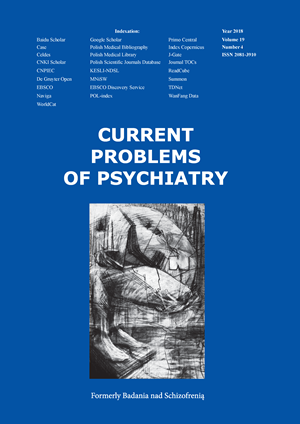Safety of concomitant treatment with Non-Vitamin K Oral Anticoagulants and SSRI/SNRI antidepressants
DOI:
https://doi.org/10.2478/cpp-2018-0021Słowa kluczowe:
SSRI, SNRI, NOAC, ryzyko krwawienia, interakcje lekoweAbstrakt
Wstęp: Warfaryna z grupy antagonistów witaminy K od 1954 roku uznawana jest za „złoty standard” w zapobieganiu i leczeniu powikłań zatorowo-zakrzepowych. Wprowadzone na rynek w ostatnich latach bezpośrednie antykoagulanty (NOAC-Non-Vitamin K antagonist Oral Anticoagulants) takie jak apiksaban, dabigatran, edoksaban oraz riwaroksaban zyskują coraz większą popularność w związku z brakiem konieczności kontroli krzepnięcia krwi, ze stałym dawkowaniem, pełną skutecznością już od pierwszego dnia, mniej restrykcyjną dietą, mniejszymi interakcjami z innymi lekami a przez to mniejszym ryzykiem krwawienia i większym komfortem życia.
Cel: Ocena bezpieczeństwa równoczesnego stosowania nowych doustnych antykoagulantów (NOACs) z lekami z grup Selektywnych Inhibitorów Wychwytu Zwrotnego Serotoniny (SSRI) oraz Inhibitorów Wychwytu Serotoniny i Noradrenaliny (SNRI).
Metoda: Dokonano narracyjnego przeglądu literatury w bazach PubMed i w Google Scholar używając słów kluczowych: Selective Serotonin Reuptake Inhibitor, Serotonin and Noradrenaline Reuptake Inhibitors, apixaban, dabigatran, edoxaban, rivaroxaban, bleeding, interaction, depression oraz deskryptorów czasowych 2014-2018. Przeanalizowano także zalecenia: National Institute for Health and Care Excellence (UK), Clinical Excellence Commission (Australia), Thrombophilia and Anticoagulation Clinic (USA), British National Formulary (UK) oraz charakterystykę produktu leczniczego każdego z preparatów.
Wyniki:
- Serotonina uwalniana z płytek krwi pełni ważną rolę w podtrzymywaniu ciągłości łożyska naczyniowego, podczas gdy leki z grupy SSRI oraz SNRI zmniejszają transport serotoniny do płytek krwi, zwiększając ryzyko krwawienia.
- Pomimo większego bezpieczeństwa w stosowaniu NOAC w stosunku do warfaryny, należy zachować ostrożność podczas równoczesnego stosowania NOAC wraz z SSRI/SNRI, na co wskazują wyniki nielicznych badań dotyczących interakcji farmakodynamicznych.
- Nie zaleca się stosowania NOAC z silnymi inhibitorami i aktywatorami CYP3A4 oraz P-gp Wnioski: Z powodu ciągle ograniczonej liczby badań i publikacji należy pamiętać o ostrożnym równoczesnym stosowaniu NOAC z SSRI i SNRI zwłaszcza, jeśli istnieją inne czynniki ryzyka zwiększające ryzyko krwawienia.
Wnioski: Z powodu ciągle ograniczonej liczby badań i publikacji należy pamiętać o ostrożnym równoczesnym stosowaniu NOAC z SSRI i SNRI zwłaszcza, jeśli istnieją inne czynniki ryzyka zwiększające ryzyko krwawienia.
Bibliografia
1. Barr D, Epps QJ. Direct oral anticoagulants: a review of common medication errors. J Thromb Thrombolysis. 2019; 47(1):146-154.
2. Is there an interaction between warfarin and proton pump inhibitors? [Cited 13.01.2019]. Accessible at: https://www.sps.nhs.uk/wpcontent/uploads/2017/02/UKMI_QA_WarfarinPPI_Sept_2017.docx
3. Wang Y, Bajorek B. New oral anticoagulants in practice: pharmacological and practical considerations. Am J Cardiovasc Drugs. 2014; 14(3):175-89.
4. Ingrasciotta Y, Crisafulli S, Pizzimenti V, Marcianò I, Mancuso A, Andò G, et al. Pharmacokinetics of new oral anticoagulants: implications for use in routine care. Expert Opin Drug Metab Toxicol. 2018; 14:1057-1069.
5. Dexxience [EU]. BevyxXa [US] Venous thromboemolism (VTE) prevention – first line – in at risk adult patients hospitalised for an acute medical illness [Cited 13.01.2019]. Accessible at: https://www.sps.nhs.uk/medicines/betrixaban/
6. Gelosa P, Castiglioni L, Tenconi M, Baldessin L, Racagni G, Corsini A, et al. Pharmacokinetic drug interactions of the non-vitamin K antagonist oral anticoagulants (NOACs). Pharmacol Res. 2018; 135:60-79.
7. ELIQUIS, INN-apixaban. Aneks I Charakterystyka produktu leczniczego. [Cited 03.01.2019]. Accessible at: http://leki.urpl.gov.pl/files/16_Eliquis.pdf
8. Pradaxa, INN-dabigatran etexilate. Aneks I Charakterystyka produktu leczniczego [Cited 03.01.2019]. Accessible at: http://leki.urpl.gov.pl/files/25_PRADAXA_kap_tw.pdf
9. Lixiana, INN-edoxaban. Aneks I Charakterystyka produktu leczniczego. [Cited 03.01.2019]. Accessible at: http://ec.europa.eu/heal th/documents/communityregister/
2015/20150619132091/anx_132091_pl.pdf
10. Xarelto, INN-rivaroxaban. Aneks I Charakterystyka produktu leczniczego. [Cited 03.01.2019]. Accessible at: http://leki.urpl.gov.pl/files/Xarelto.pdf
11. Paradise HT, Berlowitz DR, Ozonoff A, Miller DR, Hylek EM, Ash AS, et al. Outcomes of anticoagulation therapy in patients with mental health conditions. J Gen Intern Med. 2014; 29(6):855-61.
12. Michal M, Prochaska JH, Keller K, Göbel S, Coldewey M, Ullmann A, et al. Symptoms of depression and anxiety predict mortality in patients undergoing oral anticoagulation: Results from the thrombEVAL study program. Int J Cardiol. 2015; 187:614-9
13. José F, Nasser N, Almeida MM, Silva LS, Almeida RGP, et al. Psychiatric disorders and cardiovascular system: heart-brain interaction. Int J Cardiovasc Sci. 2016; 29(1): 65-75.
14. Low Y, Setia S, Lima G. Drug-drug interactions involving antidepressants: focus on desvenlafaxine. Neuropsychiatr Dis Treat. 2018; 14:567-580.
15. Browne JA, Sandberg BF, D'Apuzzo MR, Novicoff WM. Depression Is Associated With Early Postoperative Outcomes Following Total Joint Arthroplasty. J Arthroplasty. 201; 29(3):481-3.
16. Hackett ML, Pickles K. Part I: frequency of depression after stroke: an updated systematic review and meta-analysis of observational studies. Int J Stroke. 2014; 9(8):1017-25.
17. Jennum P, Baandrup L, Iversen HK, Ibsen R, Kjellberg J. Mortality and use of psychotropic medication in patients with stroke: a population-wide, register-based study. BMJ Open. 2016; 6(3):e010662.
18. NOACs and Antidepressants – What are the risks of using these together and how should these risks be managed? [Cited 04.01.2019]. Accessible at: https://www.sps.nhs.uk/wp-content/uploads/2018/07/SW_QA_225.2_NOACS_Antidepress_-Final.docx
19. Yano JM, Yu K, Donaldson GP, Shastri GG, Ann P, Ma L, et al. Indigenous bacteria from the gut microbiota regulate host serotonin biosynthesis. Cell. 2015; 161(2):264-76.
20. Steffel J, Verhamme P, Potpara TS, Albaladejo P, Antz M, Desteghe L, et al. The 2018 European Heart Rhythm Association Practical Guide on the use of non-vitamin K antagonist oral anticoagulants in patients with atrial fibrillation. Eur Heart J. 2018; 39(16):1330-1393.
21. Palleria C, Di Paolo A, Giofrè C, Caglioti C, Leuzzi G, Siniscalchi A, et al. Pharmacokinetic drug-drug interaction and their implication in clinical management. J Res Med Sci. 2013; 18(7):601-10.
22. Kennedy C, Brewer L, Williams D. Drug interactions. Medicine. 2016; 44(7): 422-426.
23. Zanger UM, Raimundo S, Eichelbaum M. Cytochrome P450 2D6: overview and update on pharmacology, genetics, biochemistry. Naunyn Schmiedebergs Arch Pharmacol. 2004; 369(1):23-37.
24. Scheen AJ. Cytochrome P450-mediated cardiovascular drug interactions. Expert Opin Drug Metab Toxicol. 2011; 7(9):1065-82.
25. Mulder H, Heerdink ER, van Iersel EE, Wilmink FW, Egberts AC. Prevalence of patients using drugs metabolized by cytochrome P450 2D6 in different populations: a cross-sectional study. Ann Pharmacother. 2007; 41(3): 408-13.
26. Silva R, Vilas-Boas V, Carmo H, Dinis-Oliveira RJ, Carvalho F, de Lourdes Bastos M, et al. Modulation of P-glycoprotein efflux pump: induction and activation as a therapeutic strategy. Pharmacol Ther. 2015; 149:1-123.
27. PRAM, INN-citalopram. Charakterystyka produktu leczniczego. (Cited 19.01.2019). Accessible at: http://chpl.com.pl/data_files/2013-09-18_pl-smpc-pram-17.09.2013_clean.pdf
28. Escitalopram Actavis, INN-escitalopram. Charakterystyka produktu leczniczego. (Cited 19.01.2019). Accessible at: http://chpl.com.pl/data_files/2013-08-21_escitalopram_actavis_chpl_wspolna_v014_czerwiec_2013_.pdf
29. PROZAC , INN-fluoxetine. Summary of Product Characteristics (SPC). (Cited 15.01.2019). Accessible at: https://www.medicines.org.uk/emc/product/3768/smpc
30. Fevarin, INN-fluwoksamina. Charakterystyka produktu leczniczego. (Cited 05.01.2019). Accessible at: https://pub.rejestrymedyczne.csioz.gov.pl/Pobieranie.ashx?type=2419-c
31. Sertraline. Summary of Product Characteristics (SPC). (Cited 05.01.2019) Accessible at: https://www.medicines.org.uk/emc/product/3501/smpc
32. Joint Formulary Committee (September 2018-March 2019). British National Formulary. 76th edition. London: British Medical Association and Royal Pharmaceutical Society of Great Britain. Appendix 1 Interactions, 1264.
33. BNF & BNFC App. BNF Publications- British National Formulary. (Cited 05.01.2018). Accessible at: https://www.bnf.org/products/bnfbnfcapp/
34. Clinical Excellence Commission, 2017, Non-vitamin K Antagonist Oral Anticoagulant (NOAC) Guidelines, Updated July 2017.Sydney: Clinical Excellence Commission.
35. Thrombophilia and Anticoagulation Clinic, Minneapolis Heart Institute®, Abbott Northwestern Hospital. Reviewed August 2016.
36. Giugliano RP, Ruff CT, Braunwald E, Murphy SA, Wiviott SD, Halperin JL, et al. Edoxaban versus warfarin in patients with atrial fibrillation. N Engl J Med. 2013; 369(22):2093-104.
37. Forbes HL, Polasek TM. Potential drug-drug interactions with direct oral anticoagulants in elderly hospitalized patients. Ther Adv Drug Saf. 2017; 8(10):319-328.
38. Aguiar CCT. Treatment of Depression in Patients on Anticoagulation Therapy: Antidepressant – Rivaroxaban Drug Interactions. J Drug Metab Toxicol. 2016; 7:215.
39. Caughey GE, Kalisch Ellett LM, Barratt JD, Shakib S. Apixaban, concomitant medicines and spontaneous reports of haemorrhagic events. Ther Adv Drug Saf. 2017; 8(5):157-164.
40. Stöllberger C. Drug interactions with new oral anticoagulants in elderly patients. Expert Rev Clin Pharmacol. 2017; 10(11):1191-1202.
Pobrania
Opublikowane
Numer
Dział
Licencja
Prawa autorskie (c) 2018 Autorzy

Praca jest udostępniana na licencji Creative Commons Attribution-NonCommercial-NoDerivatives 3.0 Unported License.


